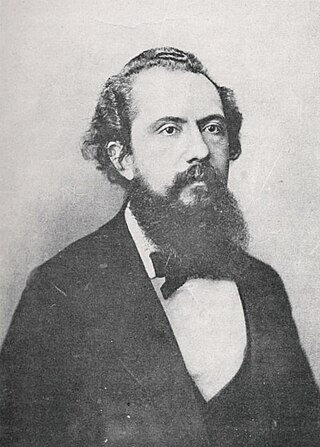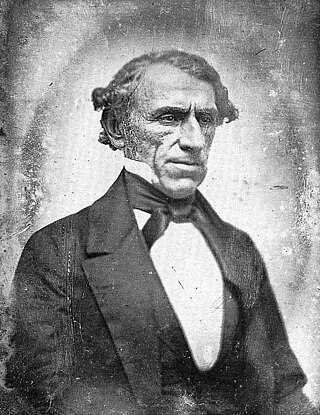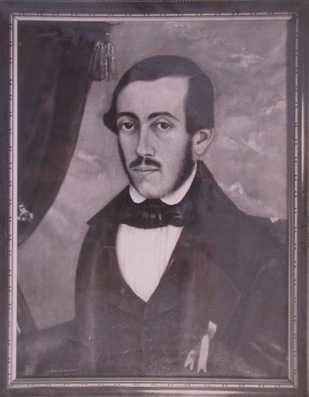Contents
| |||||
| Decades: | |||||
|---|---|---|---|---|---|
| See also: | Other events of 1871 List of years in Argentina | ||||
Events in the year 1871 in Argentina .
| |||||
| Decades: | |||||
|---|---|---|---|---|---|
| See also: | Other events of 1871 List of years in Argentina | ||||
Events in the year 1871 in Argentina .

Domingo Faustino Sarmiento was an Argentine activist, intellectual, writer, statesman and President of Argentina. His writing spanned a wide range of genres and topics, from journalism to autobiography, to political philosophy and history. He was a member of a group of intellectuals, known as the Generation of 1837, who had a great influence on 19th-century Argentina. He was particularly concerned with educational issues and was also an important influence on the region's literature.

Nicolás Remigio Aurelio Avellaneda Silva was an Argentine politician and journalist, and President of Argentina from 1874 to 1880. Avellaneda's main projects while in office were banking and education reform, leading to Argentina's economic growth. The most important events of his government were the Conquest of the Desert and the transformation of the Buenos Aires into a federal district.

Dalmacio Vélez Sarsfield was an Argentine lawyer and politician who wrote the Civil Code of Argentina of 1869, which remained in force until 2015, when it was replaced by the new Código Civil y Comercial de la Nación.

The Domingo Faustino Sarmiento Railway (FCDFS), named after the former Argentine president, statesman, educator, and author Domingo Faustino Sarmiento, is one of the six state-owned Argentine railway divisions formed after President Juan Perón's nationalisation of the Argentine railway network in 1948. The six companies were managed by Ferrocarriles Argentinos which was later broken up during the process of railway privatisation beginning in 1991 during Carlos Menem's presidency.

The Buenos Aires Western Railway (BAWR), inaugurated in the city of Buenos Aires on 29 August 1857, was the first railway built in Argentina and the start of the extensive rail network which was developed over the following years. The locomotive La Porteña, built by the British firm EB Wilson & Company in Leeds, was the first train to travel on this line.

The Buenos Aires and Rosario Railway (BA&R) was a British-owned railway company that built and operated a 5 ft 6 in broad gauge railway network in Argentina, where it was known as the "Ferrocarril Buenos Aires y Rosario". Originally thought as a line from Buenos Aires to Campana, it then extended to the provinces of Santa Fe, Santiago del Estero, and Tucumán.

The Buenos Aires & Ensenada Port Railway (BA&EP) was a British-owned company that built and operated a 5 ft 6 in broad gauge railway network in Argentina towards the end of the nineteenth century. The company was taken over by its rival the British-owned Buenos Aires Great Southern Railway (BAGS) in 1898.

The Sarmiento line is a broad gauge commuter rail service in Buenos Aires Province, Argentina, run by the state-owned Trenes Argentinos since 11 September 2013.

Eduardo Wilde was an Argentine physician, politician, and writer, and among the most prominent intellectual figures of the modernizing Generation of '80 in Argentina.

The Yellow fever in Buenos Aires was a series of epidemics that took place in 1852, 1858, 1870 and 1871, the latter being a disaster that killed about 8% of Porteños: in a city where the daily death rate was less than 20, there were days that killed more than 500 people. The Yellow Fever would have come from Asunción, Paraguay, brought by Argentine soldiers returning from the war just fought in that country, having previously spread in the city of Corrientes. As its worst, Buenos Aires population was reduced to a third because of the exodus of those escaping the scourge.
Manuel Gregorio Argerich or Manuel Argerich (1835–1871) was an Argentine philosopher, author, lawyer, politician, mathematician and medical doctor.
Events in the year 1872 in Argentina.

Benjamin Franklin Rawson was an Argentine painter who belonged to the first generation of Argentine painters called the "precursors". His best known works are the Murder of Manuel Vicente Maza and Rescue in the Cordillera.

Juan de Canaveris was an Piedmontese lawyer and politician, who served during the viceroyalty of Río de la Plata as accounting officer in the Tribunal de Cuentas de Buenos Aires. He had achieved a high social status in the Viceroyalty of the Río de la Plata, where he supported the revolutionary movements of May, being the only neighbor of Italian origin who attended in the Open Cabildo, of May 22, 1810.

Sinforoso Amoedo was an Argentine medical doctor. He served during the yellow fever epidemic of 1871.
Events in the year 1868 in Argentina.

Francisco Javier Muñiz was an Argentine colonel, legislator, and medical doctor. He treated patients and died during the Great Yellow Fever Epidemic of 1871. He was considered the first important naturalist from Argentina.

Rowing Club Argentino is an Argentine rowing club sited in Tigre, Buenos Aires, 30-km distance from the Buenos Aires autonomous city. The institution –established in 1905– was one of the pioneers in the practise of the sport in Argentina.

Buenos Aires Rowing Club is an Argentine sports club sited in Tigre, Buenos Aires, 30-km distance from the Buenos Aires autonomous city. Founded in 1873 and originally headquartered in the capital city, BARC is the oldest rowing club of Argentina.

Sanitary Works of the Nation was a state-owned company of Argentina dedicated to supplying the public with running water and sewer services. Established in 1912, the company's operation area included mostly the Buenos Aires Province area.